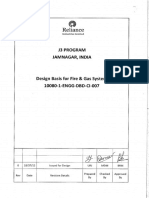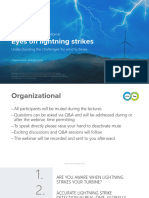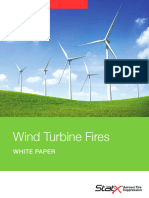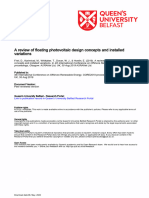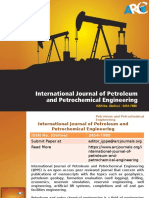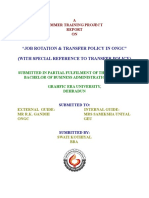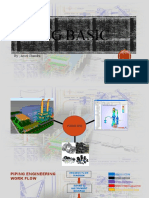CBI Taxonomy Jan2021
CBI Taxonomy Jan2021
Uploaded by
guymbulaCopyright:
Available Formats
CBI Taxonomy Jan2021
CBI Taxonomy Jan2021
Uploaded by
guymbulaOriginal Title
Copyright
Available Formats
Share this document
Did you find this document useful?
Is this content inappropriate?
Copyright:
Available Formats
CBI Taxonomy Jan2021
CBI Taxonomy Jan2021
Uploaded by
guymbulaCopyright:
Available Formats
Climate Bonds Taxonomy
JANUARY 2021
Introduction Contents
A large segment of institutional investors have indicated
their support for action to address climate change. Energy 2
However, when it comes to environmental criteria,
investors currently have too few tools to help ensure
that their investments are making a significant impact, Transport 7
particularly for debt based investments. The market needs
independent, science-driven guidance on which assets and
activities are consistent with a rapid transition to a low- Water 10
carbon economy.
The Climate Bonds Taxonomy identifies the assets and
Buildings 11
projects needed to deliver a low carbon economy and
gives GHG emissions screening criteria consistent with
the 2-degree global warming target set by the COP
Land use & marine 12
21 Paris Agreement. It has been developed based on
resources
the latest climate science including research from the
Intergovernmental Panel on Climate Change (IPCC)
and the International Energy Agency (IEA), and has
Industry 14
benefited from the input of hundreds of technical
experts from around the world. It can be used by any
entity looking to identify which assets and activities,
Waste & pollution control 15
and associated financial instruments, are compatible
with a 2-degree trajectory.
First released in 2013, the Climate Bonds Taxonomy is ICT 16
regularly updated based on the latest climate science,
emergence of new technologies and on the Climate Bonds
Standard Sector Criteria.
Using this document
A traffic light system has been adopted to indicate whether identified assets Automatically compatible
and projects are considered to be automatically compatible with a 2-degree
decarbonisation trajectory. Green Light is automatically compatible. Orange Compatible if compliant
Light is potentially compatible, depending on whether more specific criteria with screening indicator
are met. Red Light is incompatible. A Grey circle is used to indicate where
further work is required to determine which traffic light colour is appropriate Not compatible
for a specific sub-set of assets or activities.
More work required
The Taxonomy is the foundation used by the Climate Bonds Initiative Certification Criteria
to screen bonds to determine whether assets or projects underlying an Approved
investment are eligible for green or climate finance. Where detailed analysis
of a sector has been undertaken and specific eligibility Criteria have been
developed, bonds in that sector can be Climate Bonds Certified. This is
indicated via a blue ‘Climate Bonds Certification tick’. Where detailed sector
Criteria under development
based Criteria for Certification are still under development, this is indicated
by a yellow circle. In this case, bonds in this sector cannot yet be certified
under the Climate Bonds Standard.
Climate Bonds Initiative Taxonomy 1
Energy
ELECTRICITY & HEAT PRODUCTION
Asset type Asset specifics 2 degree Screening indicator Certifiable
compliant
SOLAR Generation Photovoltaic generation facilities Facilities shall have no more
facilities (onshore) than 15% of electricity
(power & generated from non-
heat) Concentrated solar power renewable sources
facilities (onshore)
Supply chain Manufacturing facilities wholly
facilities dedicated to onshore solar
energy development such as PV
cells & components, CSP dishes,
troughs & components etc
Dedicated storage, distribution,
installation, wholesale and retail
Infrastructure Dedicated transmission
infrastructure
Dedicated supporting
infrastructure including inverters,
transformers, energy storage
systems and control systems
WIND Generation Onshore wind farms Facilities shall have no more
facilities than 15% of electricity
(power & generated from nonrenewable
heat) sources
Supply chain Manufacturing facilities wholly
facilities dedicated to onshore wind energy
development such as wind turbines
Dedicated storage, distribution,
installation, wholesale and retail
Infrastructure Dedicated transmission
infrastructure
Dedicated supporting
infrastructure
GEOTHERMAL Generation Electricity generation facilities Direct emissions less than
facilities 100gCO2/kWh
(power &
heat)
Direct heat application such as
Geothermal Heat Pump (GHP)
Supply chain Manufacturing facilities wholly
facilities dedicated to geothermal
energy developments such as
geothermal turbines
Dedicated storage, distribution,
installation, wholesale and retail
Infrastructure Dedicated transmission
infrastructure
Dedicated supporting
infrastructure
Energy continues on page 3 ………>
Climate Bonds Initiative Taxonomy: Energy 2
Energy
ELECTRICITY & HEAT PRODUCTION
Asset type Asset specifics 2 degree Screening indicator Certifiable
compliant
BIO-ENERGY Facilities Facilities producing liquid (i) 80% GHG emission
producing biofuel, solid and gaseous reduction compared to fossil
biofuel, biomass for heating and fuel baseline
biomass, cogeneration
biogas AND
including fuel Facilities producing liquid
preparation biofuel, solid and gaseous (ii) Biofuel must be sourced
process biomass for electricity from a sustainable feedstock
facilities, production (only timber feedstock
pretreatment allowed is waste wood)
facilities and Facilities producing biofuel for
biorefinery transport
facilities
(if ≥50%
biomass
based
products
produced for
energy use)
Generation Electricity generation facilities (i) Emissions of electricity
facilities such as biomass power station generated must be lower than
(power, heat 100gCO2/kWh
& cooling)
AND
(ii) Biofuel must be sourced
from a sustainable feedstock
(the only timber feedstock
allowed is waste wood)
Heating facilities (ii) Emissions of biomass or
biofuel used must be 80%
Cooling facilities lower than fossil fuel baseline
and the energy efficiency
Combined Heat & Power
achieved must be at least
facilities
80%
AND
(ii) Biofuel must be sourced
from a sustainable feedstock
(the only timber feedstock
allowed is waste wood)
Supply chain Manufacturing facilities
facilities wholly dedicated to bioenergy
development
Dedicated storage, distribution,
installation and wholesale and
retail
Blending facilities
Infrastructure Dedicated transmission
infrastructure
Dedicated supporting
infrastructure
Energy continues on page 4 ………>
Climate Bonds Initiative Taxonomy: Energy 3
Energy
ELECTRICITY & HEAT PRODUCTION
Asset type Asset specifics 2 degree Screening indicator Certifiable
compliant
HYDROPOWER Generation Run of river Proposed: power density
facilities > 5W/m2; or emissions
Impoundment of electricity generated <
100gCO2e/kWh
Pumped storage
AND
Must perform an assessment,
based on recognised best
practice guidelines, of
environmental and social risks
and incorporate measures to
address risks
Only for pumped storage:
facility will not be charged
with carbon intensive energy
OR facility is contributing
to a grid which has at least
20% share of intermittent
renewables
Supply chain Manufacturing facilities wholly
facilities dedicated to hydropower devel-
opment such as hydro turbines
and components
Dedicated storage, distribution,
installation and wholesale and retail
Infrastructure Dedicated transmission
infrastructure
Dedicated supporting
infrastructure
MARINE Generation Offshore wind farms Fossil fuel back up can only
RENEWABLES facilities be used for restart capability
(power, heat Offshore solar farms and monitoring, operating
& cooling) or resilience measures in
Tidal and wave energy
the event of no power in the
generation facilities
system
Other marine electricity
generation facilities using ocean
thermals, salinity, gradients, etc
Heating or cooling facilities using Must achieve an 80%
ocean thermals reduction in gCO2e/kWh
compared to fossil fuel
alternative
Supply chain Manufacturing facilities wholly
facilities dedicated to marine renewable
energy development such as wind
turbines and platforms, vertical
and horizontal axis turbines, in-
stream generators, etc
Dedicated storage, distribution,
installation and wholesale and retail
Energy continues on page 5 ………>
Climate Bonds Initiative Taxonomy: Energy 4
Energy
ELECTRICITY & HEAT PRODUCTION
Asset type Asset specifics 2 degree Screening indicator Certifiable
compliant
MARINE Infrastructure Dedicated transmission
RENEWABLES infrastructure
Dedicated supporting
facilities, such as transmission
terminus and transformers,
grid connections, dedicated
facilities for supporting vessels,
equipment storage and onshore
assembly
FOSSIL FUELS Generation Coal or oil power without carbon
facilities capture and storage (CCS)
Coal or oil with carbon capture & CCS must capture 100% of
storage (CCS) GHG emissions
Coal or oil powered combine
heat and power (CHP)
Waste heat recovery from coal
or oil fuelled power generation
Gas power without carbon
capture & storage (CCS)
Gas power with carbon capture
& storage (CCS)
Gas powered combine heat and
power (CHP)
Waste heat recovery from gas
fuelled power generation
Mining and Coal mining or oil extraction,
extraction refining, processing or
production and associated
supply chain infrastructure
Gas extraction, refining,
processing or production
and associated supply chain
infrastructure
NUCLEAR Generation Power plants
facilities
Dedicated supporting
infrastructure
Mining Uranium mining
facilities
OTHER Generation Heat pumps using soil or air
facilities gradients
(heat)
Advanced Alternative fuel power plants
alternative
fuel power Supporting infrastructure
plants
Energy continues on page 6 ………>
Climate Bonds Initiative Taxonomy: Energy 5
Energy
Transmission, distribution & storage
Asset type Asset specifics 2 degree Screening indicator Certifiable
compliant
TRANSMISSION Infrastructure Construction or upgrading of Infrastructure supports the
& overground transmission and integration of renewable
DISTRIBUTION distribution lines energy or energy efficiency
systems and their load-
Undergrounding of lines where balancing
exposed to climate risks
Construction or upgrading of
sub-stations, buildings, fences
and busbars
Distributed Fuses, circuit breakers, Required for construction or
assets disconnectors, reactors, upgrading of transmission
capacitors, transformers, & distribution infrastructure
voltage, regulators and to reduce the curtailment of
switchgear
renewable energy into the grid
ICT / smart Controls, computers,
grid automation, sensors, smart
meters, ICT platforms and
applications
technology that is dedicated to
smart systems
STORAGE Storage Batteries, capacitors, Reduce GHG emissions by
assets compressed air storage and enabling the connection of
flywheels renewable energy, reducing
the curtailment of renewable
Facilities Large scale energy storage
facilities energy, or facilitating lower
carbon sources of electricity
Manufacture facilities dedicated generation during charging/
to any of the above storage compared to fossil
fuel options
Climate Bonds Initiative Taxonomy: Energy 6
Transport
Passenger, freight & supporting infrastructure
Asset type Asset specifics 2 degree Screening indicator Certifiable
compliant
PRIVATE Vehicles Electric passenger & freight
PASSENGER vehicles
TRANSPORT
Hydrogen passenger & freight
vehicles
Other passenger vehicles, e.g. Vehicle meets universal
hybrid vehicles gCO2/p-km (passenger per
kilometre) threshold
Supply chain Dedicated manufacturing
facilities facilities for vehicles and key
components, such as batteries,
being used in eligible vehicles
Infrastructure Dedicated charging and
alternative fuel infrastructure
(when separate from fossil fuel
filling stations and garages)
New roads, road bridges, road
upgrades, parking facilities, fossil
fuel filling stations, etc
PUBLIC Trains Rolling stock and vehicles for
PASSENGER electrified public transport,
TRANSPORT such as electrified rail, trams,
trolleybuses and cable cars
Fossil fuel or hybrid vehicles or Passenger transport system
rolling stock meets universal gCO2/p-km
(passenger-kilometre) threshold
Biofuel vehicles
Buses Buses with no direct emissions
(electric or hydrogen)
Fossil fuel or hybrid vehicles Vehicle meets universal
gCO2/p-km (passenger-
kilometre) threshold
Biofuel vehicles
Supply chain Dedicated manufacturing facilities
facilities for rolling stock, buses or key
components such as batteries,
being used in eligible vehicles
Infrastructure Dedicated infrastructure for
electrified public transport
Dedicated product or supporting Eligible if the transport mode
infrastructure for fossil fuel or supported is eligible
hybrid vehicles or rolling stock according to one of the above
Dedicated charging and
alternative fuel infrastructure
(when separate from fossil fuel
filling stations and garages)
Passenger Biofuel vehicles
cars and
commercial
vehicles
Transport continues on page 8 ………>
Climate Bonds Initiative Taxonomy: Transport 7
Transport
Passenger, freight & supporting infrastructure
Asset type Asset specifics 2 degree Screening indicator Certifiable
compliant
PUBLIC Infrastructure Public walking and cycling
PASSENGER infrastructure and cycling schemes
TRANSPORT
Bus rapid transit systems
ROAD Lorries and Vehicles with no direct emissions
FREIGHT trucks (electric or hydrogen)
All other types of lorries or trucks
(e.g. biofuel-powered or hybrid
trucks)
FREIGHT Trains Rolling stock for electrified freight Fossil fuel freight must not be
RAIL rail more than 25% of the freight
transported (in tonne/km)
Rolling stock for non-electrified (i) Fossil fuel freight must
freight rail not be more than 25% of the
freight transported (in tonne/
km)
(ii) Transport meets universal
gCO2/t-km (tonne-kilometre)
threshold
Infrastructure All infrastructure for electrified
freight rail
All infrastructure for non- Eligible if the associated rail is
electrified freight rail eligible
CROSS ICT that improves asset utilisation, Must deliver substantial GHG
CUTTING flow and modal shift, regardless of emissions savings on either
transport mode (public transport a passenger/km or a tonne/
information, car-sharing schemes, km basis
smart cards, road charging
systems, etc)
Intermodal freight facilities
Terminals to improve journey times
Smart freight logistics
Multi-modal logistics hubs
Integration of transport and
urban development planning
AVIATION Aircraft Passenger aircraft Use of low GHG fuel (e.g.
solar, electric, high % of bio-
fuel), delivering substantial
reduction in gCO2e/passen-
Cargo aircraft ger or tonne/km
Infrastructure Dedicated manufacture
Supporting infrastructure
Supporting buildings See Buildings (pg.11)
Transport continues on page 9 ………>
Climate Bonds Initiative Taxonomy: Transport 8
Transport
Passenger, freight & supporting infrastructure
Asset type Asset specifics 2 degree Screening indicator Certifiable
compliant
WATER-BORNE Cargo ships Use of low GHG fuel (e.g.
hydrogen, ammonia, electric,
high % of biofuel), deliver-
ing substantial reduction in
gCO2e/tonne/km
Passenger ships e.g. cruise ships Use of low GHG fuel (e.g.
or ferries hydrogen, ammonia, electric,
high % of biofuel), deliver-
ing substantial reduction in
gCO2e/passenger/km
Oil tankers or other ships solely
transporting coal or oil
Supporting infrastructure, e.g.
ports or manufacture
MISCEL- Vehicles Zero direct emissions
LANEOUS miscellaneous vehicles such
VEHICLES as waste collection vehicles or
construction vehicles
Supply chain Dedicated manufacturing
facilities facilities for vehicles and key
components, such as batteries,
being used in eligible vehicles
Infrastructure Dedicated charging and
alternative fuel infrastructure
(when separate from fossil fuel
filling stations and garages)
Climate Bonds Initiative Taxonomy: Transport 9
Water
Supply management & wastewater treatment
Asset type Asset specifics 2 degree Screening indicator Certifiable
compliant
WATER Water Smart networks, early warning
INFRASTRUCTURE monitoring systems for storms, droughts,
floods or dam failure, water
quality or quantity monitoring
processes
Water Rainwater harvesting systems, No net GHG emissions are
Storage storm water management expected, and the issuer
systems, water distribution discloses the justification for
systems, infiltration ponds, this decision with supporting
aquifer storage, groundwater documentation
recharge systems, sewer
systems, pumps, sand dams OR
Water Drinking water treatment, water Negative net GHG emissions
treatment recycling systems, wastewater are expected, and the issuer
treatment facilities, manure and has estimated and delivered
slurry treatment facilities the GHG mitigation impact
Ecological retention system, that will be delivered over the
current force reduction operational lifetime of the
mechanisms project or asset
Water Rainwater harvesting systems,
distribution gravity fed canal systems,
pumped canal or water
distribution systems, terracing
systems, drip, flood and pivot
irrigation systems
Water Seawater desalination The average carbon intensity
desalination plants and brackish water of energy used to power the
desalination plants plant must be at or below
100g CO2/kWh over the
remaining lifetime of the asset
Flood Surge barriers, pumping
defences stations, levees, gates
Nature based Water storage from aquatic No net GHG emissions are
solutions ecosystems, aquifer storage, expected, and the issuer
snowpack runoff, groundwater discloses the justification for
recharge systems, riparian this decision with supporting
wetlands documentation
Flood defences by ecological OR
retention, restoration of riparian
Negative net GHG emissions
wetlands, relocation of assets
are expected, and the issuer
Drought defences by aquifer has estimated and delivered
storage, recharge zone the GHG mitigation impact
management, wetland that will be delivered over the
management, operational lifetime of the
project or asset
Water treatment by natural
filtration systems, forest and
fire management
Stormwater management
by permeable surfaces,
erosion control systems,
evapotranspiration systems
Products Water saving technologies
Climate Bonds Initiative Taxonomy: Water 10
Buildings
Commercial, residential & energy efficiency
Asset type Asset specifics 2 degree Screening indicator Certifiable
compliant
BUILDINGS Commercial Including offices, hotels, retail An emissions footprint in
buildings buildings, public buildings, the top 15% of emissions
educational buildings, performance in the local
healthcare buildings etc. market
Residential Private dwellings OR
buildings
Multifamily residential A substantial reduction
buildings in gCO2/m2 because of
upgrade or retrofit
Other Data centres See ICT (pg. 16)
building types
Stations and related buildings See Transport (pg.7)
for eligible transport
Industrial buildings See Industry (pg.14)
PRODUCTS Energy Facilities dedicated to See Industry (pg.14)
AND SYSTEMS efficiency manufacturing energy efficient
FOR BUILDING components
EFFICIENCY
Low carbon Low carbon and alternative
building building materials such as
materials alternatives to cement and
concrete
Urban development
BUILT Urban or Such as neighbourhood level The built environment or
ENVIRONMENT semi-urban works, upgrades and retrofits specific programme must
areas such as street lighting improve its emissions
performance (gCO2/m2)
substantially
URBAN Infrastructure District heating for residential Fed primarily by renewable
PLANNING and commercial applications energy
Building, maintaining or Significant resource
upgrading utility tunnels for and energy efficiency
cables or pipelines improvements
Other Urban policies and regulations Significant impact on urban
directed to climate change emissions
mitigation e.g. car-free areas
Climate Bonds Initiative Taxonomy: Buildings 11
Land use & marine resources
Agriculture, husbandry, aquaculture & seafood
Asset type Asset specifics 2 degree Screening indicator Certifiable
compliant
AGRICULTURE Agricultural Agricultural land - including Demonstration of significant
(INCLUDING production land used for the production carbon sequestration,
MIXED USE of crops, agroforestry and reduction in emissions or
PRODUCTIVE silvopastoral systems, land compatibility with ‘low
SYSTEMS) used to rear livestock carbon agriculture’ targets
Livestock
Agricultural production on
peatland
Infrastructure Machinery and equipment to Eligible if the agricultural
manage and cultivate eligible production adheres with the
land or livestock above
Associated management,
information systems and other
technologies
Drip, flood and pivot irrigation See Water (pg.10)
systems
COMMERCIAL Forests Plantations and natural forests No conversion from natural
FORESTRY & timber landscape and health of the
production forest is well managed
Timber production on peatland
Infrastructure Machinery and equipment to Eligible if the forest and
manage and cultivate eligible timber production adheres
forested land with the above
Associated management,
information systems and other
technologies
Pulp & paper Production facilities incorporating
efficient pulping process, bio-
refineries, use of recyclates
NATURAL Land Land remediation and clean up Habitat is appropriate for the
ECOSYSTEM location and is maintained in
PROTECTION good health
&
Natural ecosystem land
RESTORATION
(managed and unmanaged)
Infrastructure Machinery and equipment to Eligible if the related land is in
manage eligible ecosystems compliance with the above
Associated management and
information systems and other
technologies
Land Use continues on page 13 ………>
Climate Bonds Initiative Taxonomy: Land use & seafood 12
Land use & marine resources
Agriculture, husbandry, aquaculture & seafood
Asset type Asset specifics 2 degree Screening indicator Certifiable
compliant
FISHERIES AND Fisheries Wild fisheries and farmed fish Must hold certification for
AQUACULTURE sustainable management
Infrastructure Machinery and equipment to Eligible if the fishery or
manage and harvest in fisheries aquaculture operation
and fish farms e.g. fishing adheres with the above
vessels
On shore and off shore fish
processing and storage facilities
connected to eligible fisheries
and fish farms
Associated management,
information systems and other
technologies
SUPPLY CHAIN Supply chain Input supply systems for seed Facility is sustainable
ASSETS production, distribution and managed and certified as
MANAGEMENT access such
Primary processing and storage Eligible if agricultural produce
facilities for eligible agricultural complies with relevant
produce Criteria
Primary processing and storage Eligible if forest produce
facilities for eligible forestry complies with relevant
produce Criteria
Primary processing facilities Eligible if fish produce
and storage for eligible complies with relevant
fisheries and aquaculture Criteria
activities
Climate Bonds Initiative Taxonomy: Land use & seafood 13
Industry
Industrial & energy intensive processes
Asset type Asset specifics 2 degree Screening indicator Certifiable
compliant
PRIMARY Cement Production facilities,
RESOURCES production incorporating dry processes,
facilities reduced clinker content
Steel, iron & Extraction facilities and
aluminium equipment, incorporating electric
production arc furnace, smelting reduction,
facilities efficient casting processes
Chemical Production facilities
production incorporating lower carbon
ammonia feedstocks, catalyst
intensification
Glass Production facilities
production incorporating efficient process
facilities heating, use of recyclates
Other Various
primary
production
facilities
FUEL Biofuel See Bioenergy (pg.3) See Bioenergy (pg.3)
PRODUCTION production
facilities
Hydrogen
fuel
production
facilities
CLEAN UP Carbon Facilities and products for clean-
scrubber up, such as treatment of exhaust
gases from industrial plants
Products dedicated to clean-up
or efficiency of fossil fuel energy
Carbon Facilities and products CCS has the ability to capture
Capture dedicated to CCS 100% of GHG emissions
& Storage
(CCS)
OTHER Secondary Various
INDUSTRY & processing
MANUFACTURING & manufac-
turing
SUPPLY CHAIN Manufactur- Facilities dedicated to Eligible if dedicated to
ing facilities manufacturing key components an eligible asset type e.g.
for eligible facilities solar panel or wind turbine
manufacture
Facilities dedicated to Energy efficiency rating
manufacturing energy efficient amongst top performers in
appliances and equipment e.g. the market
fridges, cookers etc
Other supply Facilities dedicated to the Eligible if dedicated to an
chain storage, distribution or eligible asset type e.g. all
retail of eligible industrial or electric rail supply chain
manufactured products
Climate Bonds Initiative Taxonomy: Industry 14
Waste and pollution control
Recycling, re-use & other waste managements
Asset type Asset specifics 2 degree Eligibility criteria Certifiable
compliant
PREPARATION Facili- Facilities and assets Made from 100% recycled and recyclable
ties for with high recovery materials. Supports source segregation of
collection, rates of reusable or waste
sorting and recyclable material
material
recovery Collection of waste Collection vehicles must meet Transport
that is going to landfill Criteria
WASTE Waste Storage and bulking Dedicated to eligible waste processing asset(s)
STORAGE storage facilities downstream. Those downstream assets do
facilities not need to be certified but do need to meet
the criteria for that asset type. All waste stored
must be transferred to those assets
Collection vehicles Must meet Transport Criteria
RE-USE Facilities Facilities refurbishing The products are put back to their original
for the or repairing products use without any further pre-processing
re-use of or cleaning compo- required. For WEEE, the product is covered
materials nents or products for by ecolabelling scheme and only those
reuse in their original products meeting the three lowest energy
function use categories are eligible
RECYCLING Facilities Facilities for recycling The secondary raw materials (such as steel,
for the or metals, plastics, aluminum, glass, plastics) cease to be waste
recycling of glass (except and are sold to be used as secondary raw
materials aggregate) and paper materials
BIOLOGICAL Anaerobic Facilities for the Total methane emissions <= 1285g CH4/
TREATMENT digestion production of biogas tonne of waste input. Woody waste must
FACILITIES facilities from green waste be segregated before or after processing
and sent to an eligible EfW or composting
plant. Monitoring, sampling and control of
the following is carried out in accordance
with PAS110 guidance. The solid and liquid
products are not landfilled and replace non-
waste materials in the market
Composting Facilities for the Zero measurable methane emissions.
facilities production of Monitoring, sampling and control is carried
compost from out in accordance with PAS100 guidance.
residual waste The resulting product is not landfilled and
replaces non-waste material in the market
WASTE TO Waste to Facilities for solid Only facilities outside the EU are potentially
ENERGY energy waste treatment eligible. Plant efficiency >= 25%; AND Bottom
plants (e.g. with production of ash recovery; AND >= 90% recovery of metal
incineration, electricity or heat as from ash; AND Average carbon intensity of
gasification, a by-product electricity and/ or heat over the life of the plant
pyrolysis <= waste management allowance; AND capacity
and of the plant does not exceed the calculated
plasma) residual waste at any time in the plant’s life
LANDFILL Landfill Projects to add gas Biogas from closed landfill facilities. Gas capture
with gas capture to existing, >= 75%; AND gas used to generate electricity and
capture closed landfill input to the natural gas grid or used as vehicle fuel;
facilities AND the landfill is not accepting further waste
(with the exception of restoration materials)
Landfill
without gas
capture
Climate Bonds Initiative Taxonomy: Waste and pollution control 15
Waste and pollution control
Recycling, re-use & other waste managements
Asset type Asset specifics 2 degree Eligibility criteria Certifiable
compliant
RADIOAC- Nuclear
TIVE WASTE waste
MANAGE- treatment
MENT
Nuclear
waste
disposal
WASTEWATER Water See Water (pg.10)
treatment
Information & communications technology
Networks, management & communication tools
Asset type Asset specifics 2 degree Climate Certifiable
compliant compatible
indicator
BROADBAND Broadband networks Fibre optic and cable networks
NETWORKS
Supporting infrastructure Such as internet exchange points
IT SOLUTIONS Connectivity Teleconferencing and telecommuting
software and service
Data hubs Including data storage centres
Supporting Such as hardware and manufacture of
infrastructure hardware
POWER Infrastructure, software Remote solutions for appliance power
MANAGEMENT and hardware for remote management, and load-balancing of
power management renewables
In situ power Including automatic switching, energy
management monitoring & data systems
Revisions and updates to the Climate Bonds Taxonomy
The Climate Bonds Taxonomy is a working document. It will be revised and updated periodically as developments are
made in the Climate Bonds Standard Sector Criteria and in international green bond policies. It will also be revised
when low carbon trajectories from prominent research institutions are released and updated.
Climate Bonds Initiative has an active role in developing international green bond policy and keeps up-to-date with
the latest climate science and low carbon development trajectories through its Technical Working Groups and
through external engagement and research.
Updates will be announced on the Climate Bonds Blog.
Climate Bonds Initiative © January 2021 www.climatebonds.net
Disclaimer: The information contained in this communication does not constitute investment advice in any form and the Climate Bonds Initiative is not an investment adviser. Any reference to a financial organ-
isation or debt instrument or investment product is for information purposes only. Links to external websites are for information purposes only. The Climate Bonds Initiative accepts no responsibility for content
on external websites. The Climate Bonds Initiative is not endorsing, recommending or advising on the financial merits or otherwise of any debt instrument or investment product and no information within this docu-
ment should be taken as such, nor should any information in this communication be relied upon in making any investment decision. Certification under the Climate Bond Standard only reflects the climate attributes
of the use of proceeds of a designated debt instrument. It does not reflect the credit worthiness of the designated debt instrument, nor its compliance with national or international laws. A decision to invest in
anything is solely yours. The Climate Bonds Initiative accepts no liability of any kind, for any investment an individual or organisation makes, nor for any investment made by third parties on behalf of an individual or
organisation, based in whole or in part on any information contained within this, or any other Climate Bonds Initiative public communication.
Climate Bonds Initiative Taxonomy: Information & communications technology 16
You might also like
- 10080-1-ENGG-DBD-CI-007 - 0 - Design Basis For Fire and Gas SystemDocument36 pages10080-1-ENGG-DBD-CI-007 - 0 - Design Basis For Fire and Gas SystemDinesh Boopalan100% (2)
- EE Ebook MicrogridsDocument16 pagesEE Ebook MicrogridsWaseemNo ratings yet
- Global Facilities - Electrical - Electrical Specification Design StandardDocument202 pagesGlobal Facilities - Electrical - Electrical Specification Design StandardaizatmaricanNo ratings yet
- CBI TaxonomyDocument17 pagesCBI TaxonomyerwindosorioNo ratings yet
- Green Incentives and Soft LoanDocument26 pagesGreen Incentives and Soft LoanhuskyjackNo ratings yet
- Strategic Market Report - Large Scale PV Power Plants - Brazil - 2023 - GCDocument86 pagesStrategic Market Report - Large Scale PV Power Plants - Brazil - 2023 - GCArthur CampanerNo ratings yet
- IrChrisLODocument18 pagesIrChrisLOvincentvanclNo ratings yet
- Demeter - As Good As GoldDocument15 pagesDemeter - As Good As Goldteamseekers.virtuoso24No ratings yet
- Siemens Gamesa Environmental Product Declaration Epd SG 8-0-167 PDF Original FileDocument9 pagesSiemens Gamesa Environmental Product Declaration Epd SG 8-0-167 PDF Original Fileqales.kl12No ratings yet
- Green Ko BrochureDocument20 pagesGreen Ko Brochurevinod babhaleNo ratings yet
- Energy Efficiency As An Investment Proposition: 26 November 2009Document17 pagesEnergy Efficiency As An Investment Proposition: 26 November 2009Matteo BonardelloNo ratings yet
- 6CV 1 6Document6 pages6CV 1 6Caroline WilliamsNo ratings yet
- 1. IntroductionDocument8 pages1. IntroductionHyungwoo JangNo ratings yet
- 1 s2.0 S2090447923004239 MainDocument16 pages1 s2.0 S2090447923004239 MainAli TNo ratings yet
- POWER Magazine - May 2023-1Document43 pagesPOWER Magazine - May 2023-1MarcialgonzalezpNo ratings yet
- Guide To Renewable Energy-NHBCDocument19 pagesGuide To Renewable Energy-NHBCJoy100% (1)
- Focus On: Gas PowerDocument44 pagesFocus On: Gas PowerStefanos DiamantisNo ratings yet
- Meralco Renewable Energy IntegrationDocument18 pagesMeralco Renewable Energy Integrationavranque54No ratings yet
- 3.4. Methodologies For Small-Scale CDM Project ActivitiesDocument11 pages3.4. Methodologies For Small-Scale CDM Project ActivitiesDaya EgasNo ratings yet
- Tealing Battery Supporting and Planning StatementDocument39 pagesTealing Battery Supporting and Planning Statementzhangzuxun0413No ratings yet
- Up-To-Date Literature Review On Solar PV SystemsDocument19 pagesUp-To-Date Literature Review On Solar PV Systemszhyk990No ratings yet
- DTU International Energy Report 2015 RevDocument103 pagesDTU International Energy Report 2015 RevonlyhappysheepNo ratings yet
- Emergency Generators For Resilient Response To Natural Disasters 79 PaperDocument8 pagesEmergency Generators For Resilient Response To Natural Disasters 79 PaperjovenlouNo ratings yet
- Grid Connected Rooftop Solar System PDFDocument28 pagesGrid Connected Rooftop Solar System PDFdebasisdgNo ratings yet
- 1 PAPER 1 MAIN PAPER. Application of Hybrid RE in 29 Bus SystemDocument15 pages1 PAPER 1 MAIN PAPER. Application of Hybrid RE in 29 Bus SystemMuhammad ShaarifNo ratings yet
- Webinar Lightning Common Presentation 2024 ENDocument58 pagesWebinar Lightning Common Presentation 2024 ENTiago Kaoru MatsuoNo ratings yet
- Demeter - Final - As Good As GoldDocument17 pagesDemeter - Final - As Good As Goldteamseekers.virtuoso24No ratings yet
- Beylot2014 PDFDocument5 pagesBeylot2014 PDFOsmar RGNo ratings yet
- Distributor GeneratorDocument7 pagesDistributor GeneratorMateus PeduzziNo ratings yet
- Wind-Turbine-Fires-White-PaperDocument4 pagesWind-Turbine-Fires-White-Papermclardiekatilynn62No ratings yet
- Distributed Generation: Mohammad Amin Latifi Bureau of Privatization Ministry of EnergyDocument54 pagesDistributed Generation: Mohammad Amin Latifi Bureau of Privatization Ministry of EnergyDharmender KumarNo ratings yet
- Technical and Economic Assessment of PV-coupled Energy Storage Systems A Case Study From Italy Based On Field-DataDocument4 pagesTechnical and Economic Assessment of PV-coupled Energy Storage Systems A Case Study From Italy Based On Field-DataenriqueNo ratings yet
- Emerging Sustainable Design Technologies For Green BldgsDocument42 pagesEmerging Sustainable Design Technologies For Green BldgsmajortayNo ratings yet
- Renewable and Sustainable Energy ReviewsDocument19 pagesRenewable and Sustainable Energy ReviewsAdrian RamosNo ratings yet
- 8c - Climate Champions Regional Project List - UNECE FinalDocument41 pages8c - Climate Champions Regional Project List - UNECE FinalGiovanni AndradeNo ratings yet
- Assessment Report On Green Bond Initiatives Sep05Document13 pagesAssessment Report On Green Bond Initiatives Sep05nilesh.gole1992No ratings yet
- Thermo-economic assessment of flexible nuclear power plants in futureDocument18 pagesThermo-economic assessment of flexible nuclear power plants in futureabeer fatimaNo ratings yet
- Irjet V5i520Document5 pagesIrjet V5i520baby hNo ratings yet
- Elastic Energy Proportional Edge Computing Infrastructure Solution Brief 793758v1Document13 pagesElastic Energy Proportional Edge Computing Infrastructure Solution Brief 793758v1Lakad ChowdhuryNo ratings yet
- WindDocument30 pagesWindtharun0% (1)
- Studies of Distributed Energy Supply Systems Using An Innovative Energy Management SystemDocument4 pagesStudies of Distributed Energy Supply Systems Using An Innovative Energy Management SystemJeison GomezNo ratings yet
- Data Center 33011 PDFDocument102 pagesData Center 33011 PDFdexiNo ratings yet
- PCM 2Document19 pagesPCM 2malkeabo2019No ratings yet
- Introduction To The Residential Wind Industry Residential Wind IndustryDocument21 pagesIntroduction To The Residential Wind Industry Residential Wind IndustryDennyHalim.comNo ratings yet
- A Review of Floating Photovoltaic Design Concepts and Installed Variations 2019Document17 pagesA Review of Floating Photovoltaic Design Concepts and Installed Variations 2019Ho Wing FungNo ratings yet
- GinerELX ESMCDocument12 pagesGinerELX ESMCJurun BidanshiNo ratings yet
- Approach On Carbon Neutral Manufacturing-2016Document53 pagesApproach On Carbon Neutral Manufacturing-2016ansarNo ratings yet
- 2014 Buck Tower CSP Techology 0Document88 pages2014 Buck Tower CSP Techology 0Wanderson WadjôNo ratings yet
- Micro GridsDocument20 pagesMicro Gridshaydee sakrNo ratings yet
- DR R Meenakumari, Professor and Head, EEE, KECDocument48 pagesDR R Meenakumari, Professor and Head, EEE, KECoremkayNo ratings yet
- TP21OB Earth ResistanceDocument27 pagesTP21OB Earth ResistanceManoj PriyangaNo ratings yet
- Renewable and Sustainable Energy Reviews: Adam Hirsch, Yael Parag, Josep Guerrero TDocument10 pagesRenewable and Sustainable Energy Reviews: Adam Hirsch, Yael Parag, Josep Guerrero TkalokosNo ratings yet
- Distributed Generation & Renewable Energy Technologies: by Mohammed ADocument31 pagesDistributed Generation & Renewable Energy Technologies: by Mohammed Ahabte gebreial shrashrNo ratings yet
- Ecoislands Shown The Wight Way To Go Green With Smart Grid and Hydrogen EnergyDocument4 pagesEcoislands Shown The Wight Way To Go Green With Smart Grid and Hydrogen EnergyAlberto BarrosNo ratings yet
- Lecture 5Document111 pagesLecture 5jayshreeNo ratings yet
- JNNSM FinalDocument42 pagesJNNSM FinalPMG Bhuswal ProjectNo ratings yet
- A Novel Solution To Prevent Diesel Pilferage at Telecom Tower SiteDocument11 pagesA Novel Solution To Prevent Diesel Pilferage at Telecom Tower SiteSyed Furqan RafiqueNo ratings yet
- Mperc Net Metering Regulations-Wip-28.10.2021Document32 pagesMperc Net Metering Regulations-Wip-28.10.2021Sandeep Guha NiyogiNo ratings yet
- Decarbonising End-use Sectors: Green Hydrogen CertificationFrom EverandDecarbonising End-use Sectors: Green Hydrogen CertificationNo ratings yet
- Innovation Landscape brief: Behind-the-meter batteriesFrom EverandInnovation Landscape brief: Behind-the-meter batteriesNo ratings yet
- The Origination of The PirogueDocument1 pageThe Origination of The PirogueguymbulaNo ratings yet
- DRAFT Climate Bonds Standard v4 Public Consultation 060922 FinalDocument46 pagesDRAFT Climate Bonds Standard v4 Public Consultation 060922 FinalguymbulaNo ratings yet
- Central Bank Digital Currencies. Motives, Economic Implications and The Research FrontierDocument30 pagesCentral Bank Digital Currencies. Motives, Economic Implications and The Research FrontierguymbulaNo ratings yet
- Form 5 - Dealer ApplicationDocument6 pagesForm 5 - Dealer ApplicationguymbulaNo ratings yet
- Lolc Ar 2020 (5mb)Document346 pagesLolc Ar 2020 (5mb)guymbulaNo ratings yet
- Public Debt Act of 1941: HearingDocument51 pagesPublic Debt Act of 1941: Hearingguymbula100% (1)
- Consultation Paper On MiFID II and MiFIRDocument64 pagesConsultation Paper On MiFID II and MiFIRguymbulaNo ratings yet
- Why Change in A Central BankDocument10 pagesWhy Change in A Central BankguymbulaNo ratings yet
- Ensuring Operational Continuity in ResolutionDocument14 pagesEnsuring Operational Continuity in ResolutionguymbulaNo ratings yet
- Central Bank Communication and Monetary Policy PDFDocument57 pagesCentral Bank Communication and Monetary Policy PDFguymbulaNo ratings yet
- Quiz Questions For 2016Document3 pagesQuiz Questions For 2016saumya ranjan lenka100% (1)
- LMXpress Tech Propos AngDocument29 pagesLMXpress Tech Propos AngtaxissmsNo ratings yet
- ATC 2012 Full Conference PreviewDocument16 pagesATC 2012 Full Conference PreviewAAPG_Events100% (1)
- De Cuong On Tap Tieng Anh 7 HK2 Global Nam 22 23Document6 pagesDe Cuong On Tap Tieng Anh 7 HK2 Global Nam 22 23Thơ ĐỗNo ratings yet
- 21eb7 0 PDFDocument1 page21eb7 0 PDFJosef MadronaNo ratings yet
- 2nd Law of Thermodynamics Contradicts Greenhouse TheoryDocument14 pages2nd Law of Thermodynamics Contradicts Greenhouse TheorymaygracedigolNo ratings yet
- General Aspect of Energy Management and Energy AuditDocument259 pagesGeneral Aspect of Energy Management and Energy Auditpradeepdesaiuch67% (3)
- International Journal of Petroleum and Petrochemical Engineering - ARC JournalsDocument5 pagesInternational Journal of Petroleum and Petrochemical Engineering - ARC JournalsARC JOURNALSNo ratings yet
- ACER 2024 MMR Key Developments GasDocument28 pagesACER 2024 MMR Key Developments Gaspgnigtermika2023No ratings yet
- Lecture 4 Fuels and CombustionDocument54 pagesLecture 4 Fuels and CombustionGuilbert FajardoNo ratings yet
- JPT July PDFDocument132 pagesJPT July PDFAdri Coca SuaznabarNo ratings yet
- Chapter 8 - Transport, Energy and Environment: Paradoxical Environmental SystemsDocument24 pagesChapter 8 - Transport, Energy and Environment: Paradoxical Environmental SystemsRomani Noel S. Chavez Jr.No ratings yet
- Ships and Classification of Merchant ShipsDocument41 pagesShips and Classification of Merchant ShipsAlp ŞENER100% (2)
- Design and Layout Problem For A Combined GasDocument119 pagesDesign and Layout Problem For A Combined GasAshley Espeso VeluzNo ratings yet
- FPEC PetroBowl Competition SampleQuestions 2013.5Document15 pagesFPEC PetroBowl Competition SampleQuestions 2013.5Nur Syaffiqa Mohamad Ruzlan100% (2)
- Nozzle Check ValvesDocument12 pagesNozzle Check Valvesjshadwan100% (1)
- CGD Report 12Document63 pagesCGD Report 12Saurabh Dubey50% (2)
- Job Rotation and Policy at OngcDocument46 pagesJob Rotation and Policy at Ongcvipul tandon100% (1)
- Piping Basic: by Aries ChandraDocument18 pagesPiping Basic: by Aries ChandraAries Chandra Abu Hasan100% (1)
- COURSE INFORMATION - RES FinalDocument16 pagesCOURSE INFORMATION - RES FinalDHARANIKA T C1557No ratings yet
- BrazilThe PROMINP Program PetrobrasDocument20 pagesBrazilThe PROMINP Program Petrobrask_fatahiNo ratings yet
- 3rd Sem EOR ProjectDocument35 pages3rd Sem EOR ProjectVishal KumarNo ratings yet
- 2009 Final Program - Revised.final.91809pdfDocument16 pages2009 Final Program - Revised.final.91809pdfAliya JamesNo ratings yet
- Blue and White Clean Modern Company Project ProposalDocument19 pagesBlue and White Clean Modern Company Project Proposalmdprv5167rkNo ratings yet
- Hydrocarbon VisionDocument10 pagesHydrocarbon VisionKamakshi JoshiNo ratings yet
- Dholpur Combined Cycle Power Plant ReportDocument59 pagesDholpur Combined Cycle Power Plant Reportdhananjay100% (2)
- Booz & Co Iraq Energy Strategy ReportDocument174 pagesBooz & Co Iraq Energy Strategy ReportferitbinzetNo ratings yet
- Top Tier: LNG Contractors Liquefaction PlantsDocument1 pageTop Tier: LNG Contractors Liquefaction PlantsHoang NamNo ratings yet
- Unit-Ii: - Generation of Steam - Fuel Utilization - Electric Power UtilizationDocument22 pagesUnit-Ii: - Generation of Steam - Fuel Utilization - Electric Power UtilizationKishore KumarNo ratings yet
- 023 BP RefiningDocument27 pages023 BP Refiningpartho143No ratings yet
